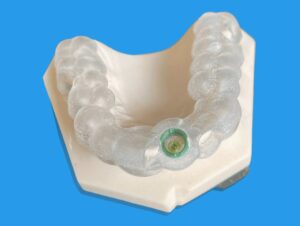Evaluation and Treatment Planning– Prior to any surgical procedure, Dr. Gittleman spends a significant amount of time evaluating and planning your smile makeover in order to successfully achieve your desired results. Dr. Victor Gittleman will evaluate and analyze your medical history, teeth, gums, bone structure, and the current state of your oral health. The evaluation process will begin by taking a 3D X-ray with a state-of-the-art Cone Beam CT Scan (CBCT), which allows him to plan and place the implants. This advanced imagery takes the guesswork out of the process by enabling Dr. Gittleman to precisely determine the proper placement of dental implants and protect surrounding nerves.

Fabrication of a Surgical Guide
Dr. Gittleman uses digital diagnostics in all phases of the implant process to ensure a perfect outcome. In most cases, we use a surgical guide when placing the implant for greater accuracy during the procedure. A surgical guide is created using images taken with our CBCT scanner. It is created to fit over your existing adjacent teeth with marking for the exact location of where the new implant will be placed.
Why is the exact placement of an implant important?
A surgical guide allows Dr. Gittleman to better control the location, angle and depth of the implant. The surgical guide leverages the imagery taken with our CBCT scanner so that your implant is placed where there is healthy and stable bone structure and puts it in the most ideal restorative position. This is a key element for a successful and healthy long-term outcome.
Surgical Procedure to Place Implants– Once Dr. Gittleman has prepared the surgical treatment plan and fabricated the surgical guide (if applicable), the next step is the actual surgery where Dr. Gittleman will place the implant into the area of your missing or extracted teeth. Bone grafting material is also commonly placed in conjunction with the implant in order to aide with the integration of the implant to the bone. Once the implant is placed, Dr. Gittleman will place a healing cap over the area to protect the implant during the integration process. In a process called osseointegration, the bone cells fuse to the implants creating a strong bond. This is the longest part of the entire implant process and one which typically averages 4 months in most patients.
It will take some time for the bone and implants to properly fuse together. During the integration period, a healing abutment is attached to the implant and the space remains empty until full integration occurs. A temporary dental restoration may be placed in the mouth immediately after the implant surgery if the missing tooth is in a highly visible area.
Restorative Phase
At the time your implant is placed, our office will also schedule an appointment approximately 4 months from the date of the implant surgery. This is a short evaluative appointment where the doctor will check to make sure the implant has fully integrated with the bone before proceeding with the restorative process. Once integration is confirmed, Dr. Gittleman will take impressions which are sent to the lab where the implant abutment and implant-supported crown are fabricated. The lab process restorations are subsequently secured onto the implant, which will look and function like a natural tooth.
